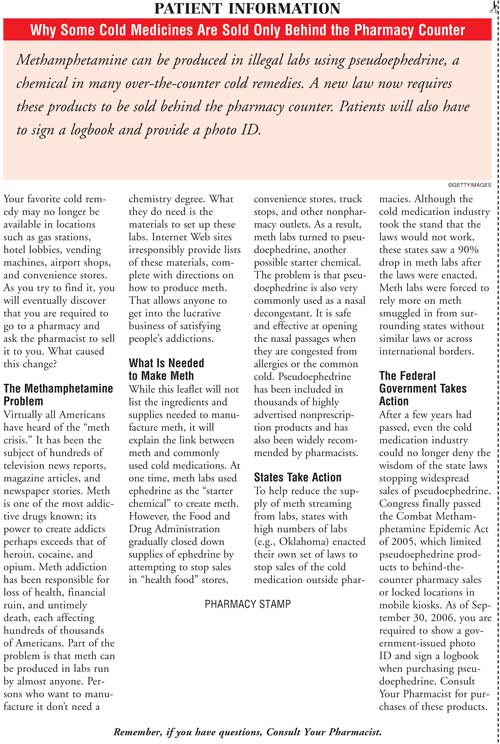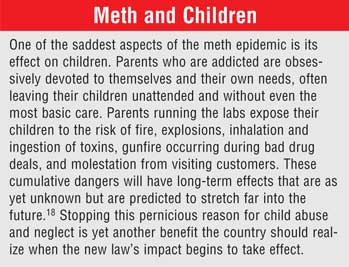US Pharm. 2006;10:16-23.
The methamphetamine crisis has destroyed health and caused the deaths of many hundreds of thousands of Americans, financially ruined the lives of uncounted millions, and given frightening new terms to the English language, such as "meth labs" and "Nazi method" (a specific method of manufacturing methamphetamine).1
Scope of the Problem
The number of
Americans who have used meth at least once is estimated to be 12.3 million (5%
of the population).2 The highly addictive nature of meth ensures
that many of these "one-time users" will become long-term addicts. As many as
600,000 people use it each week.2 Meth is now at the top of the
list of drugs (including legal medications) leading to emergency department
visits.3 In 2006, "drug czar" John Walters, Director of the White
House Office of National Drug Control Policy, stressed that hospitals and
police departments were becoming overwhelmed by meth-related problems, a
situation even more acute in small towns in the rural West and Midwest.3
Individual States Control Meth
With the meth
crisis growing more severe in the beginning of this decade, it was left to
individual states to take the initiative. State regulatory officials realized
that controlling the primary starter chemical, pseudoephedrine (PSE), could
help reduce the output of meth labs. In April 2004, Oklahoma was first to pass
a state law restricting sales of PSE through pharmacies alone, an act
motivated by the meth-related deaths of peace officers. It removed the
chemical from nonpharmacy venues, e.g., gas stations and convenience stores.
During this time, the law was harshly criticized by the Consumer Healthcare Products Association (CHPA) on its Web site. This organization of the nonprescription drug manufacturers stated that it opposed the Oklahoma law because it was "overly restrictive and misguided." It also stated that the law "conveys a false sense of comfort in communities and does nothing to address the vast majority of meth used in Oklahoma or in the U.S."4 The crusade against strict control of PSE, if successful, would have likely ensured that the chemical would have remained widely available for use by meth labs.
CHPA's reasoning was based on a false premise and was quickly proved wrong. The Oklahoma law was described as directly responsible for a 70% to 100% drop in meth labs in some areas just seven months after it went into effect.5,6 Prior to the law's passage, agents closed an average of 104 meth labs each month. By March 2006, they seized only two labs per month.7 In 2006, Brad Henry, governor of Oklahoma, stated, "We have virtually wiped out the existence of mom-and-pop meth labs in the state of Oklahoma."7 Walters hailed the Oklahoma law as revolutionary and prescient. He stated, "You [in Oklahoma] were in the forefront of saying if we cut off the necessary ingredients, we can cut down a lot of the production and a lot of the destruction that use of that substance causes, and you proved it correct."7 Walters indicated that the Oklahoma law served as the model for the upcoming national law.

The Evolution of a National Law
President Bush
signed the Patriot Act on March 9, 2006; this legislation included the Combat
Methamphetamine Epidemic Act of 2005 (hereafter referred to as "the Act").
8 The reference to the year 2005 may be misleading, as the meth control
portion of the law did not take effect until 2006. Restrictions on sale
amounts went into effect on March 9, 2006. As of September 30, however, the
more restrictive provisions took effect. The Drug Enforcement Admin istration
(DEA) will enforce the Act.8
Provisions of the Law
Provisions of the
Act are well documented in several easily accessible locations.8-11
Briefly, the FDA explains that the Act's goal to be the ban of OTC sales of
ingredients commonly used to make meth.8 The list of banned
ingredients included ephedrine, PSE, and phenylpropanolamine.
Phenylpropanolamine is of little concern at present, since the FDA effectively
banned it several years ago when it was implicated in causing hemorrhagic
stroke.10 As for ephedrine, OTC sale was banned by the FDA until a
Utah judge reversed the ban. However, on August 21, 2006, the Tenth Circuit
Court of Appeals upheld the FDA final rule, declaring all dietary supplements
containing ephedrine alkaloids to be adulterated and illegal for marketing in
the U.S.12
PSE is the main subject of the September provisions of the Act. Any product containing the popular and effective oral nasal decongestant will be stored and sold only under special conditions after September 30. This is described by the FDA as "behind the counter."8 The Act describes two potential sales entities known as "regulated sellers": pharmacies and "mobile retail vendors." 9,11 A mobile retail vendor is a person or business making retail sales from a movable stand, such as a mall or airport kiosk. Strangely, the Act allows PSE sales by these nonpharmacy businesses. If a mobile retail vendor sells PSE, however, it must be stored in a locked cabinet.
The Act regulates sales of PSE in several important aspects. The DEA created presentations on the training required for pharmacies and mobile retail vendors to sell PSE-containing products.13,14 It restricts purchasers to those with a government-issued (state or federal) photo ID. The seller must keep a logbook in which the purchaser will record the name, address, and date and time of sale; the purchaser must then sign the logbook. The seller will record the medication name and quantity sold. The seller must verify that the purchaser's name on the ID matches the name in the logbook and that the date and time written by the purchaser are correct. The product must be given directly to the purchaser who signed the logbook.
The logbook must be kept secure but may be shared with local, state, and federal law enforcement. The logbook may be copied, inspected, or turned over entirely, as law enforcement personnel require. The logbooks must be kept for two years.8 Electronic logbooks are an option allowed by the Act.8
The amounts that may be sold vary between the two types of vendors. Both are permitted to sell a maximum of 3.6 g daily of PSE to any one purchaser. When hydrochloride salt is sold, a correction factor of about 1.22 must be applied to determine the amount of pure (base) PSE allowed. When applicable, a regulated seller may sell 146 tablets daily of a product containing 30 mg of PSE, 73 tablets daily of a product containing 60 mg of PSE, and 36 tablets daily of a product containing 120 mg of PSE.11,13,14 Similarly, if a liquid contains 15 mg of PSE per 5 mL, the purchaser would be restricted to 1,464 mL daily. There is a difference in the amount that pharmacies versus mobile retail vendors may sell to any one customer in a 30-day period: Pharmacy purchasers are limited to 9 g, while the customers of mobile retail vendors are limited to 7.5 g.
Department of Justice and FDA Web sites both explain a puzzling exemption in the Act. Customers who purchase a single package containing no more than 60 mg of PSE do not have to sign the logbook or show identification.8,13,14 Nevertheless, those single packages must remain behind the pharmacy counter or locked up by the mobile vendor.
Any company selling PSE will be required to submit a statement to the U.S. Attorney General regarding self-certification and training on the Act.8 If there are any questions about the Act, pharmacists may contact the FDA at (888) 463-6332 or e-mail the agency at druginfo@cder.fda.gov.8
If any state has a more restrictive law than the federal act, the more restrictive aspects of the state law must be followed. For instance, Oklahoma law restricts purchases to those older than 18 and also requires purchasers to provide their date of birth, a prohibition not found in the 2005 federal act.15
Is Phenylephrine a Viable Option?
Many companies have
chosen to reformulate with phenylephrine (PE), a nasal decongestant that was
seldom used in oral products until the meth crisis. Pharmacists will notice
that PE labels (e.g., Sudafed PE) recommend dosing every four hours, as
opposed to some single-entity and combination PSE products that allow dosing
every 12 or 24 hours (e.g., Claritin-12, Claritin-24). Taking a product every
four hours is less convenient and may cause compliance problems for those with
allergies and colds.
Drs. Hendeles and Hatton explored the original 1976 studies used by the FDA advisory panel to rule on the efficacy of oral PE. All were manufacturer-sponsored and unpublished. Furthermore, only four studies demonstrated efficacy for the 10-mg dose now being sold; another seven found the 10-mg dose no better than placebo. The authors characterized the panel's finding as "a specious conclusion that was not based on a systematic review of the available data."16 Their paper was cited by ranking minority congressman Rep. Henry Waxman in a letter to FDA on August 23, 2006. The letter indicated that PE is only 38% bioavailable, whereas PSE is 90% bioavailable.17 "Phenylephrine apparently does not work when used as an oral nasal decongestant." Waxman also requested that FDA provide an explanation by September 8, 2006, for why it still considers a 10-mg PE dose to be effective.

The Pharmacist's Role
The pharmacist can
describe to patients the controversy over the unknown efficacy of oral
phenylephrine. The pharmacist can explain why the national law was passed, its
potential to stop the meth epidemic, and why their favorite cold remedies may
no longer be as easily available as they once were. The pharmacist can also
assure patients that products with pseudoephedrine are still available behind
the counter.
REFERENCES
1. Glittenberg J,
Anderson C. Methamphetamines: use and trafficking in the Tucson-Nogales area.
Subst Use Misuse. 1999;34:1977-1989.
2. Roehr B. Half a
million Americans use methamphetamine every week. BMJ. 2005;331:476.
3. Tanne JH.
Methamphetamine epidemic hits middle America. BMJ. 2006;332:382.
4. Consumer Healthcare
Products Association. FAQs about methamphetamine. Formerly available from:
www.chpa-info.org/web/press_room/faqs/methamphetamine.aspx#10._What_is_CHPA's_position_on_the_restriction_of_sales_of_legitimate_OTCs.
Accessed October 20, 2004.
5. Casteel C. Panel
hears state's meth success story. Oklahoman. November 19,
2004:13A.
6. Raymond K. Law
credited in rapid decline of illegal drug labs in Oklahoma. Oklahoman.
November 19, 2004:13A.
7. McNutt M. Drug czar
says meth law was model for U.S. effort. Oklahoman. March 9, 2006:5A.
8. Food and Drug
Administration. Legal requirements for the sale and purchase of drug products
containing pseudoephedrine, ephedrine, and phenylpropanolamine. Available at:
www.fda.gov/cder/news/methamphetamine.htm. Accessed September 2, 2006.
9. Public Law 109-177.
March 9, 2006. USA Patriot Improvement and Reauthorization Act of 2005. Title
VII-Combat Methamphetamine Epidemic Act of 2005. Available at:
www.gpoaccess.gov/plaws/index.html. Accessed September 2, 2006.
10. Bren L. Some cold
medicines move behind counter. Food and Drug Administration. Available at:
www.fda.gov/fdac/features/2006/406_meth.html. Accessed September 2, 2006.
11. U.S. Department of
Justice Drug Enforcement Administration. The Combat Meth Act of 2005.
Available at: www.deadiversion.usdoj.gov/meth/cma2005.htm. Accessed September
2, 2006.
12. Food and Drug
Administration. FDA statement on Tenth Circuit's ruling to uphold FDA decision
banning dietary supplements containing ephedrine alkaloids. Available at:
www.fda.gov/bbs/topics/NEWS/2006/NEW01434.html. Accessed September 2, 2006.
13. U.S. Department of
Justice Drug Enforcement Administration. Training required to sell drug
products containing ephedrine, pseudoephedrine, and phenylpropanolamine by
mobile retail vendors. Available at:
www.deadiversion.usdoj.gov/meth/trg_mobile_081106.pdf. Accessed September 2,
2006.
14. U.S. Department of
Justice Drug Enforcement Administration. Training required to sell drug
products containing ephedrine, pseudoephedrine, and phenylpropanolamine.
Available at: www.deadiversion.usdoj.gov/meth/trg_retail_081106.pdf. Accessed
September 2, 2006.
15. Oklahoma State
Board of Pharmacy. Frequently asked questions. Available at:
www.ok.gov/OSBP/Frequently_Asked_Questions/index.html. Accessed September 2,
2006.
16. Hendeles L, Hatton
RC. Oral phenylephrine: an ineffective replacement for pseudoephedrine?
[Letter]. J Allergy Clin Immunol. 2006;118:279-280.
17. Committee on
Government Reform Minority Office. Rep. Waxman requests investigation of
effectiveness of phenylephrine nasal decongestants. Available at:
www.democrats.reform.house.gov/story.asp?ID=1096. Accessed September 2, 2006.
18. Denehy J. The meth epidemic: its
effect on children and communities. J Sch Nurs. 2006;22:63-
65.
To comment on this article, contact editor@uspharmacist.com






